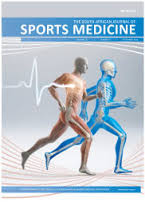A comparative analysis of physical fitness characteristics and rugby-specific game skills of schoolboy players by playing standards: Implications for talent identification programs in resource-constrained settings
DOI:
https://doi.org/10.17159/2078-516X/2024/v36i1a18525Abstract
Background: Rugby has not grown extensively in Africa compared to other continents, necessitating talent identification (TID) programs to recruit junior talent. However, it is unclear which physical characteristics and rugby-specific game skills to base the objective recruitment of potentially talented young players.
Objectives: This study profiled the physical fitness characteristics and rugby-specific game skills of schoolboy rugby players by playing standards to identify variables differentiating elite from sub-elite players from Under 16 (U16) to U19 age categories. The study further compared Zimbabwean cohort data with similar data from international/regional countries.
Methods: A cross-sectional design was utilised with 158 Zimbabwean schoolboy players playing competitive (elite) and non-competitive (sub-elite) rugby. The participants were measured for anthropometrics, speed, agility, upper-and-lower-muscular strength/power, muscle flexibility, prolonged high-intensity intermittent running ability, repeated high-intensity exercise performance ability, tackling, passing, and catching abilities.
Results: For U16s, Vertical Jump (VJ), 2kg Medicine Ball Chest Throw (2kg MBCT), Wall-Sit-Leg Strength (WSLS), Yo-Yo Intermittent Recovery Level 1 (Yo-Yo IRL1), Tackling and Catching Ability tests discriminated elite from sub-elite players. Among U19s, the following tests differentiated elite from sub-elite players: VJ, 2kg MBCT, WSLS, 20-m/40-m linear speed, 60-s Push Up, One-Repetition Maximum Back Squat (IRM BS), 1RM Bench Press (BP), Repeated High-Intensity Exercise (RHIE), Tackling and Passing Ability. Elite Zimbabwean schoolboy rugby players were significantly leaner, slower, and “weaker” than their international/regional counterparts.
Conclusion: The results suggest important physical fitness characteristics and rugby-specific game skills for future identification of potentially talented players at U16/U19 categories.
Downloads
Downloads
Published
Issue
Section
License
Copyright (c) 2024 South African Journal of Sports Medicine

This work is licensed under a Creative Commons Attribution 4.0 International License.
The South African Journal of Sports Medicine reserves copyright of the material published. The work is licensed under a Creative Commons Attribution 4.0 (CC BY 4.0) International License. Material submitted for publication in the South African Journal of Sports Medicine is accepted provided it has not been published elsewhere. The South African Journal of Sports Medicine does not hold itself responsible for statements made by the authors.
How to Cite
- Abstract 213
- PDF 149
- PDF (Supplementary) 32






.png)